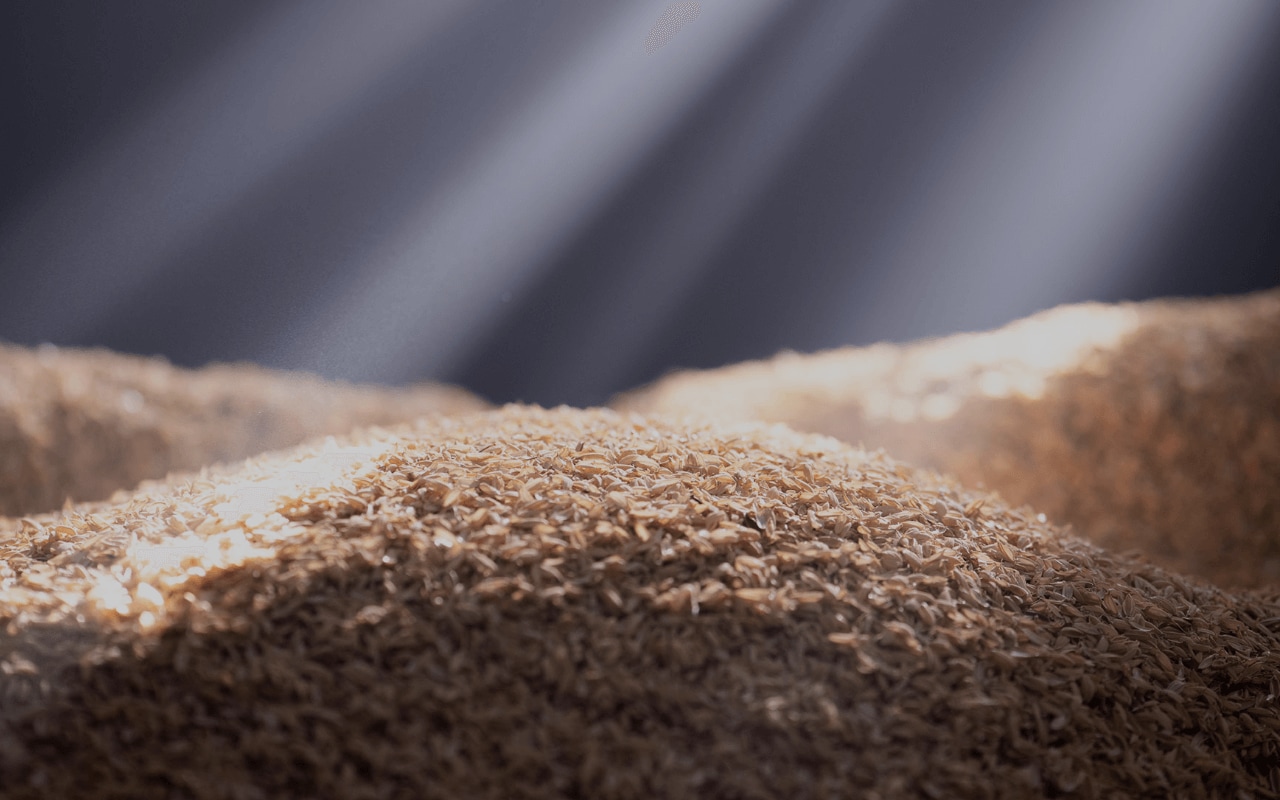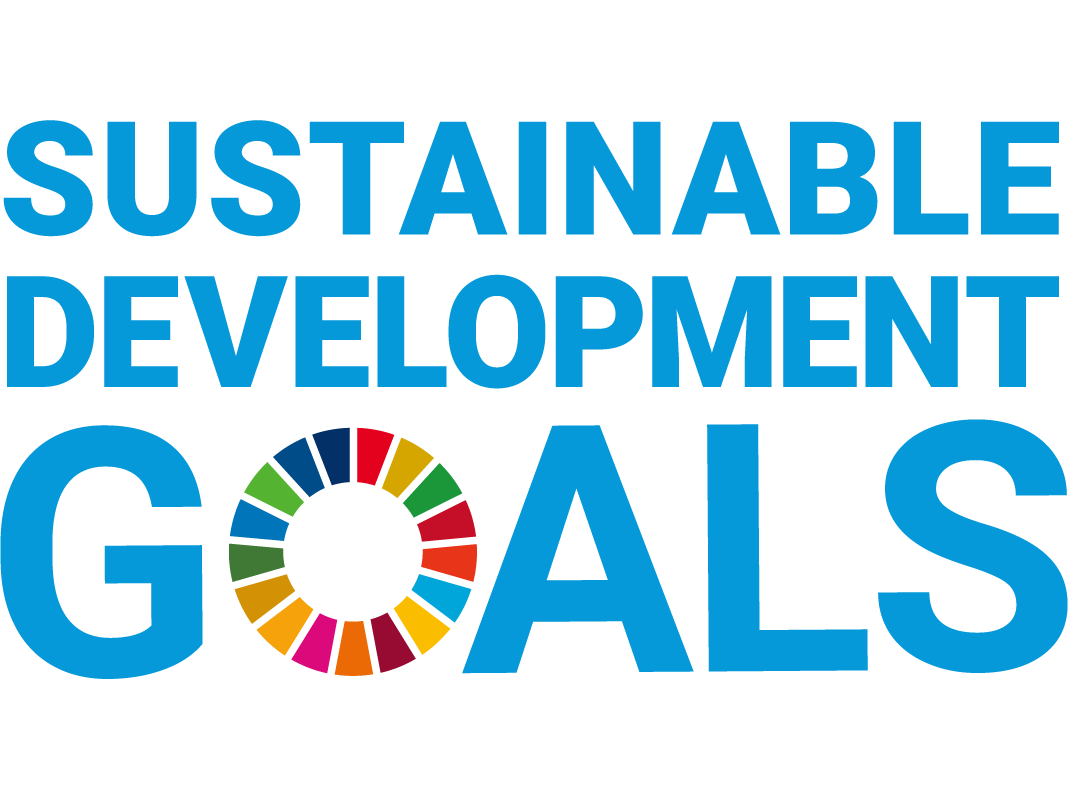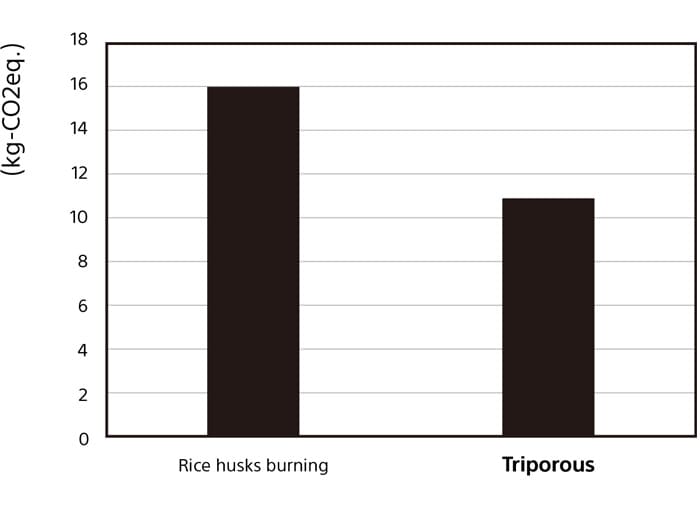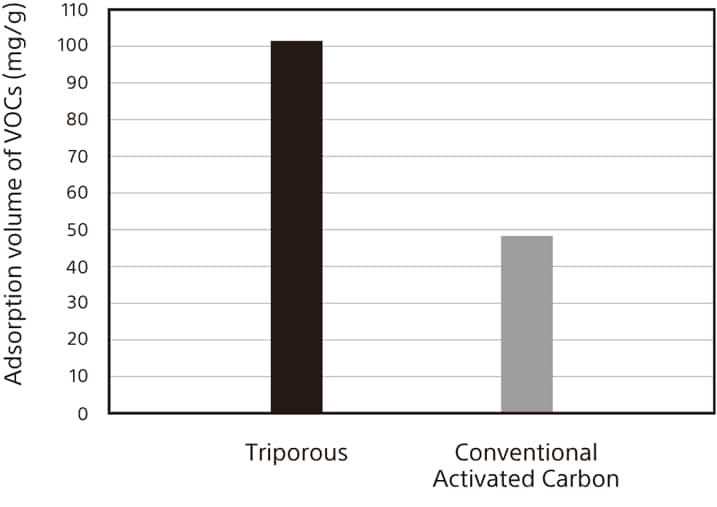

Sustainability
Sustainable Material using Excess Biomass
In recent years, increasingly large amounts of activated carbon have been produced from raw materials such as coal and coconut shells for use as adsorbent materials in applications ranging from air and water purification to production of skin cleansers and other body care products.
In the course of R&D work on battery electrode materials, Sony discovered that rice husks have a unique micro structure.
Taking advantage of this structure, Sony developed Triporous™, a new plant-derived porous carbon material*1 with excellent adsorption properties.
Considering that Japan alone generates about 2 million tons of rice husk waste annually
and the total annual worldwide amount is estimated to be more than 100 million tons,
the utilization of this excess biomass to produce Triporous helps contributing to the realization of a more environmentally conscious, recycling-oriented society.
In 2014, Sony received The 21st Century Encouragement of Invention Prize from the Japan Institute of Invention and Innovation for developing Triporous technology.
- *1 The material with numerous microscopic pores that adsorb other substances.

Contribution to the Sustainable Development Goals (SDGs)
Through Triporous, Sony is working on solving social issues and contributing to Sustainable Development Goals (SDGs) adopted by United Nations.


Through Triporous, Sony supports the Sustainable Development Goals
1. Triporous helps contributing to the recycling-oriented society by utilization of rice husks as excess biomass (Goal #12)
Over 100 million tons of rice husks are estimated to be wasted worldwide every year, with about 2 million in Japan alone.
100kg of Triporous can be generated from 1 ton of rice husks.
By recycling the huge mass of excess rice husks, Sony contribute to recycling-oriented society and realization of circular economy.

Goal and Target
Goal #12 RESPONSIBLE CONSUMPTION & PRODUCTION
Target #12.5 By 2030, substantially reduce waste generation through prevention, reduction, recycling and reuse
2. Contributing to decrease air pollutants and greenhouse gas emissions caused by the disposal of rice husks (Goal #11, 13)
According to Food and Agriculture Organization (FAO) of United Nations, more than 400 million tons*2 of biomass, including rice husks,
are currently disposed annually worldwide through burning.
Intergovernmental Panel on Climate Change (IPCC) reports that biomass burning is a source of greenhouse gases (GHG) and PM2.5*3.
Sony conducted a life cycle assessment (LCA) in the manufacture process of Triporous.
Producing 1 kg of Triporous from 10 kg of rice husks can is expected to greatly reduce GHG emissions and PM2.5 compared to burning the same amount of rice husks.
Sony will expand Triporous as a new way to use the rice husks in the world and contribute to improving air pollution and climate change mitigations.
- *2 Source: FAOSTAT - Food and agriculture data
- *3 Source: IPCC Special Report on Climate Change and Land

PM2.5 emissions of open burning of rice husks and Triporous Production*4,5

GHG emissions of open burning of rice husks and Triporous Production*4,5

GHG emissions of open burning of rice husks and Triporous Production

- *4 Source: Frontiers in Energy Research, 8 (2021)
-
*5
Using the LCA method of ISO 14040, the greenhouse gas emissions from the production of 1 kg of Triporous were calculated under the following conditions.
- The functional unit is the production of 1 kg of Triporous.
- The scope of calculation covers the collection and transportation of rice husks, grinding, pellet production, carbonization, silica removal, and steam activation.
- The processes of rice husk collection and transportation, grinding, pellet production, carbonization, and silica removal were calculated based on the assumption that they were conducted in India, while the steam activation process was conducted in Japan.
- The raw material, rice husks, is byproduct of rice production and are used as feed, fertilizer, soil conditioner, etc.
Since it is difficult to identify alternatives, we treated it as having no environmental impact. - CO2 emissions from biomass were included in the calculation.
- Triporous is assumed that some of the CO2 absorbed by plants in the growth process was fixed.
- Sodium hydride generated in the silica removal process is treated as a byproduct, and its weight is allocated and calculated.
- IDEAv2.3 was used for the calculation.
Goals and Targets
Goal #11 SUSTAINABLE CITIES AND COMMUNITIES
Target #11.6 By 2030, reduce the adverse per capita environmental impact of cities, including by paying special attention to air quality and municipal and other waste management
Goal #13 CLIMATE ACTION
Target #13.1 Strengthen resilience and adaptive capacity to climate-related disasters
3. Through adsorption properties of Triporous, Sony contributes to cleaning water and air (Goal #3, #6, #11)
According to a report by the World Health Organization (WHO), 2.1 billion people around the world are struggling with access to safe water*6, and approximately 7 million death are due to the exposure from both outdoor and household air pollution*7.
The unique microstructure of Triporous offers superior performance in adsorption of larger organic substances, such as virus from liquid, compared to the coconut-husk-based activated carbon adsorbent typically used in water purification.
This would be particularly beneficial in developing countries.
Triporous can also clean air by adsorbing pollutants like Volatile Organic Compounds (VOCs).
This also helps in reducing exposure to some types of microscopic particulate matter (PM2.5) and photochemical smog.
Through Triporous, Sony contributes to world’s access to safe water and improving air pollution.
- *6 Source: 2.1 billion people lack safe drinking water at home, more than twice as many lack safe sanitation
- *7 Source: 7 million premature deaths annually linked to air pollution
Effect for virus adsorption
- * Using general test water of WHO (General testing protocol #6)

Effect for VOCs removal
- * Measured by standard operating procedure of WHO (SOP 09)

Goals and Targets
Goal #3 GOOD HEALTH AND WELL-BEING
Target #3.9 By 2030, substantially reduce the number of deaths and illnesses from hazardous chemicals and air, water and soil pollution and contamination.
Goal #6 CLEAN WATER AND SANITATION
Target #6.1 By 2030, achieve universal and equitable access to safe and affordable drinking water for all
Target #6.3 By 2030, improve water quality by reducing pollution, eliminating dumping and minimizing release of hazardous chemicals and materials, halving the proportion of untreated wastewater and substantially increasing recycling and safe reuse globally
Goal #11 SUSTAINABLE CITIES AND COMMUNITIES
Target #11.6 By 2030, reduce the adverse per capita environmental impact of cities, including by paying special attention to air quality and municipal and other waste management
4. Promote R&D and business development globally with open innovation (Goal #17)
In order to introduce Triporous to society, we are promoting global open innovation with various research institutes and companies in Japan and overseas.
Goal and Target
Goal #17 PARTNERSHIPS FOR THE GOALS
Target #17.17 Encourage and promote effective public, public-private and civil society partnerships, building on the experience and resourcing strategies of partnerships

